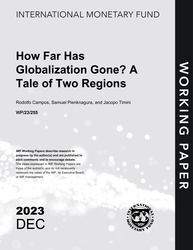
How Far Has Globalization Gone? A Tale of Two Regions
How Far Has Globalization Gone? A Tale of Two Regions
READ MORE...
Volume/Issue:
Volume 2023
Issue 255
Publication date: December 2023
ISBN: 9798400261190
$20.00
Add to Cart by clicking price of the language and format you'd like to purchase
Available Languages and Formats
| English |
Prices in red indicate formats that are not yet available but are forthcoming.
Topics covered in this book
This title contains information about the following subjects.
Click on a subject if you would like to see other titles with the same subjects.
Exports and Imports , Economics- Macroeconomics , Taxation - General , Economics / General , Industries - Manufacturing , Agribusiness , Trade , Globalization , Structural gravity , Latin America , Asia , trade globalization , globalization trend , IMF working paper 23/255 , model point , globalization process , Trade policy , Manufacturing , Agricultural sector , Tariffs , Caribbean , Asia and Pacific , Global
Also of interest
Summary
We study the evolution of trade globalization in a set of countries in Latin America (mostly the largest ones) and Asia over the past 25 years. Relying on structural gravity models, we first estimate a proxy of trade globalization that captures the ease of trading internationally with respect to trading domestically. Results indicate that the evolution of trade globalization since the mid-1990s has been similar between the two regions, but very heterogeneous within them. Trade globalization has been particularly strong in agriculture, mining and manufacturing, but has lagged in services. The paper also documents that trade globalization has been particularly strong in agriculture, mining and manufacturing, but it lagged in services. Within region heterogeneity is associated to a set of trade policy instruments, including tariffs, non-tariff measures, WTO membership. and trade agreements. Next, we quantify the economic implications of the estimated globalization trends. Simulations of a multi-sector trade model point to heterogeneous long-term impacts of globalization on GDP—some countries exhibiting substantial gains and others experiencing large losses—, with no single sector playing a preponderant role.
Copyright © 2010 - 2025
Powered by:
AIDC



